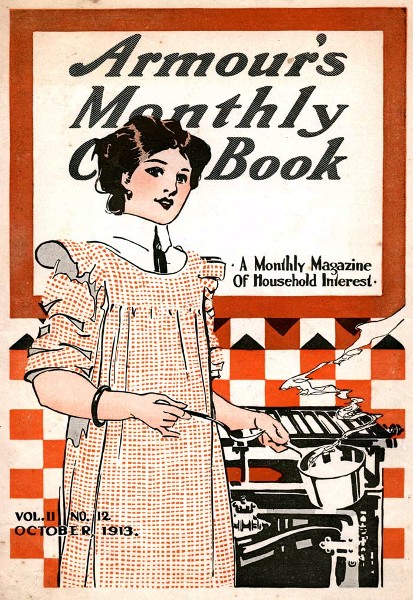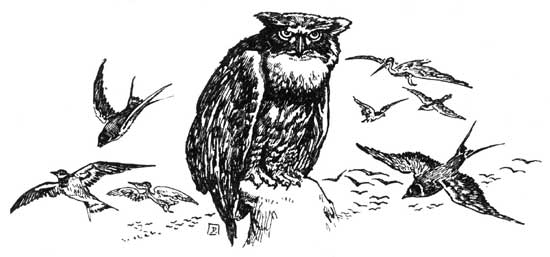Halloween decorations – for better and for worse – are becoming more prevalent as the day comes closer. There are inflatables, rotting pumpkins, and grotesque tableaux. While some have their decorations right, others need help. Where better to turn for some Halloween decorating advice than the October 1913 issue of Armour’s Monthly Cookbook: A Monthly Magazine Of Household Interest? The issue not only covered Halloween decor, but also Halloween recipes. We will start with the latter.

You can follow along with the original issue here.
Halloween Recipes
Armour’s Monthly Cookbook lived up to its name by presenting two Halloween-themed recipes in a section titled Halloween Hints, which appeared on page 6 of the original magazine. I reprint both recipes, with my commentary, below.
Witch Apples
The recipe reads as follows:
Bake large apples from which the core has been removed until soft, but not long enough to burst the skin. When cooked, insert a marshmallow into the core space, put a teaspoonful of sugar on top and a few maraschino cherries. When ready to serve turn over each a scant teaspoonful of brandy and light just as the table is reached. The brandy will burn with a ghastly flame and melt the sugar and marshmallows. Whipped cream served in a bowl is a delicious addition.
Analysis of Witch Apples
When I saw a recipe involving apples, my first thought was candied or caramel apples.
My first thought was wrong. If I had second or third thoughts, they would have been wrong too. This recipe is far more elaborate.
While I think that apple sauce is decent, I am generally not a fan of cooked apples. I prefer raw apples – which are recommended later in the issue. If I were to partake in a cooked apple, I think that it would be one that does not have a marshmallow in it. Were baked apples with melted marshmallows and brandy popular once upon a time?
I am not too sure about this recipe. Feel free to try it on my behalf and tell me how it goes.
(Aside: What makes this apple a “witch apple”?)
Witch Cake
The witch cake is baked as follows:
Cream one half cupful of butter with one and one half cupfuls of sugar; add three eggs and beat five minutes; add one cupful of milk. Sift together one third cupful of cornstarch, and two cupfuls of flour, one and one half teaspoonfuls of ground mixed spices, and three teaspoonfuls of baking powder; then add to the mixture. Now add one cupful of seeded floured raisins, also one cupful of chopped nuts. Turn into a well greased loaf cake pan and bake in a moderate oven about forty-five minutes. Frost with a white boiled icing. Melt sweet chocolate to equal one third cupful, flavor with a teaspoonful of lemon juice, add one cupful of boiled chestnuts which have been run through the meat grinder, and enough confectionery sugar to make a paste easily handled. Roll and cut (by pasteboard pattern) black cats or any other Halloween figure, press them into the icing on the sides of the cake.
Witch Cake Analysis
The witch cake not only sounds more palatable than the witch apples, but also more distinctly Halloween. Were an enterprising baker to follow the recipe to the decoration advice at the end , there would be no doubt for which occasion the cake arose.
I will note the ingredient combination is a bit odd. A chocolate-frosted cake with raisins and lemon juice? Would this not be better with some kind of cream cheese-based frosting?
It is best that I refrain from quibbling too much. After the witch apple, I will settle for this.
Halloween Decorating Advice
Halloween desserts need to be served in the proper setting. Armour’s Monthly Cookbook ensured that Halloween bakers would not be left wanting for decorating advice. This section of the magazine appeared on page 11, right under an unrelated section on home dressmaking.
Brief Halloween Commentary
The magazine began with a brief preface to its Halloween decorating advice:
The date of this oldtime celebration is always October 31st, the crucial moment 12 o’clock. To be sure, the original observance of All Hallows Eve has been considerably distorted during the course of years but the fun it affords the young folks in its present manner of keeping cannot be gainsaid and needs no changing.
All Hallows’ Eve falls on the day before All Saints’ Day, which was first recognized on a different date as a holy day of obligation by Pope Boniface IV on a different date in the 7th century. That the meaning of the day was “considerably distorted during the course of years” is a matter for less debate than its “need[ing] no changing” – at least in 2021.
Economical Halloween Decorating
Armour’s Monthly Cookbook assured readers that it was possible to decorate for a Halloween party without spending much money.
With a little time, some suitable paper and a pair of sharp scissors the witches, pumpkin faces, cats and bats, which are the distinctive features of [Halloween] decoration[s], may be easily made at home.
For this purpose, the magazine recommended purchasing yellow, red, and black crepe paper for “a few cents.” The color choices are interesting. As far as I have known, orange and black are the colors associated with contemporary Halloween. In 1913, it appears that yellow and red joined black in lieu of orange.
Witches, Cats, and Bats
What to do with the crepe paper?
For Halloween there is a design of witches with brooms, or cats and bats in black on a yellow ground. This is ready to be laid on the table as a cover or around the room in the effect of a frieze. There are napkins to match and a crepe paper rope to finish the edge.
Lanterns
Next, we have what is likely the most creative decorating advice in the magazine:
A weird effect of lighting is obtained by making lantern boxes from any discarded boxes which may be in the house. Cover them with crepe paper, cut eyes, nose, ears and mouth, pase colored tissue paper behind the features and set a lighted candle inside.
Make-at-home lanterns is a good decorating tip, although I am not sure that I would trust my contemporaries to be as apt at not setting themselves on fire as I would the women who subscribed to Armour’s Monthly Cookbook. This is the result of experiencing lighter fluid season in New York City summers.
The Wise Owl
Finally, we get to a Halloween decoration that is less frequent today:
The wise owl must not be forgotten in the Halloween decorations. Grey paper is best for him. Paste the edges of a square piece of grey crepe paper together lengthwise of the grain and gather in at the bottom. Stuff this bag with soft paper or cotton and gather again some distance from the top. Shape the top into ears and make two rosettes with black centers for eyes. A beak of black stiff paper protrudes between the eyes. Mount the owl on a branch by sewing with heavy black thread in a way to resemble claws.
I do not see many owl decorations for Halloween – certainly not compared to pumpkins, witches, ghosts, and skeletons.

The only owl-holiday story I have had occasion to cover at The New Leaf Journal involved Christmas. Yet, here the magazine emphasizes that “the wise owl must not be forgotten in the Halloween decorations.”
We could use more owls. I agree wholeheartedly with a 2005 assessment by Ms. Rose Smith at owls.com:
[T]his Halloween, put together an owl superstition trivia sheet for the guests at your Halloween party and add a friendly wise one to your decor.
Witch’s Brooms
Having already instructed readers on the proper method of preparation of witch apples and cakes, the magazine offered advice for making witches’ brooms:
Make witches’ brooks by tying slashed paper tied on any old sticks or brooms to give the effect.
Conventional, but sound, decorating advice.
Conclusion
That concludes the Halloween advice from Armour’s Monthly Cook Book. While the recipes were not entirely appetizing, the tenor of the advice was far more wholesome and amenable to children than much of the Halloween decorating I see around Brooklyn these days. The decorating ideas were clever. There is perhaps much to learn from Halloween’s past.
Especially wise owl decorations.